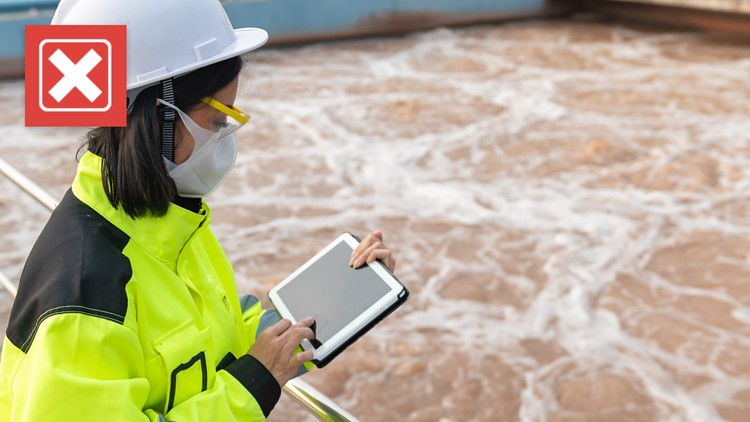Over the past couple of months, an increasing number of local municipalities have tracked the spread of monkeypox in their communities by monitoring their untreated wastewater.
On Aug. 11, the White House announced that the Centers for Disease Control and Prevention (CDC) is adding monkeypox tracking to its National Wastewater Surveillance System. The National Wastewater Surveillance System is a CDC-run partnership with local health departments that originally tracked the presence of the COVID-19 virus in wastewater.
VERIFY reader William sent an email to ask about the likelihood that monkeypox could spread through wastewater.
THE QUESTION
Is there evidence monkeypox can spread through wastewater?
THE SOURCES
- World Health Organization (WHO)
- Centers for Disease Control and Prevention (CDC)
- Yale Medicine
- Environmental Protection Agency (EPA)
- Mark Sobsey, Ph.D., a retired University of North Carolina professor who specializes in pathogens found in water, food and other environments
THE ANSWER
No, there isn’t evidence monkeypox can spread through wastewater.
WHAT WE FOUND
To date, there hasn’t been evidence of any monkeypox cases that spread through wastewater, and experts believe wastewater transmission is highly unlikely.
According to the World Health Organization (WHO), “there have been reports of traces of the virus DNA found in wastewater samples,” but “no intact virus has been found to date.”
A virus's DNA survives longer than its other parts, which is why it can be found in wastewater, but it lacks the ability to transmit the disease on its own.
“Bits of the nucleic acid can hang around very long before they get degraded,” said Mark Sobsey, Ph.D., a retired University of North Carolina professor who specializes in pathogens found in water, food and other environments.
Nucleic acids are the “NA” part of “DNA.”
“The infectivity, the ability of the virus to cause infection and illness, that gets lost relatively early on,” Sobsey continued.
Sobsey explained that viruses like monkeypox have an envelope around them. This envelope has the proteins necessary to spread disease, but the envelope is fragile and breaks down easily.
Since DNA will outlast the rest of the virus, health experts can detect the occurrence of monkeypox in a community through its wastewater. According to Stanford University, which is co-leading the WastewaterSCAN initiative to expand wastewater surveillance to monkeypox and other viruses, this testing strictly measures short pieces of viral DNA in water. Wastewater surveillance does not measure infectious virus and thus cannot detect if infectious virus is in the water.
Wastewater testing is used as an alternative to case data tracking, which can be skewed based on the frequency the public tests for disease and can lag behind the actual spread of disease. If public health experts find a lot of monkeypox DNA in a city’s sewage, that means there are likely a lot of people who have the virus.
“There has been detection of monkeypox genetic material in untreated wastewater that has been shed by infected persons and is tested using a PCR-based method similar to SAR-CoV-2 testing,” a spokesperson for the Environmental Protection Agency (EPA) said. “Presence of genetic material does not necessarily mean that virus is intact or infectious. From the evidence we have up to now, the risk is low.”
More from VERIFY: Yes, monkeypox can spread by touching contaminated surfaces, but current risk is low
On monkeypox information pages maintained by the CDC, WHO and Yale Medicine, there is no mention of wastewater as an avenue for monkeypox transmission. They all list direct contact with a person or surface contaminated with the monkeypox virus as the most common means of transmission, and list contact with respiratory secretions as another means of potential spread.
The CDC does say scientists are still researching if monkeypox can spread through feces or urine, but that is not the same as surviving in treated wastewater.
Sobsey said wastewater disinfection, often accomplished with chlorine or ultraviolet light, is used primarily to control hardier viruses without the fragile envelope, such as polio. He said that means these methods are even more effective against a weaker virus like monkeypox. Filtration methods used in water treatment are also fairly effective at removing the virus from water, Sobsey said, since monkeypox is one of the bigger viruses in physical size.
There is reason to be cautious about monkeypox in bathrooms, according to the CDC, but not because there is any risk of transmission from wastewater. If an infected person’s rash or skin lesions come into contact with a bathroom surface, such as the toilet seat, faucets or countertops, then there is a risk the virus could spread from those surfaces.
The CDC says a person with monkeypox should wipe down any surface their rash touches with disinfectant after using a bathroom, and to use disposable gloves if the rash is present on the person’s hands. Both the person with monkeypox and anyone else who uses a bathroom should wash their hands with soap and water to reduce the risk of virus surviving on their hands.



